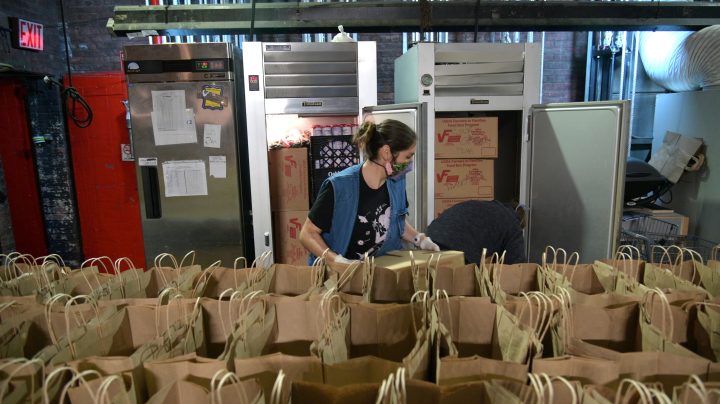
What America’s hunger crisis may look like after pandemic relief ends
What America’s hunger crisis may look like after pandemic relief ends

During the height of the pandemic, Americans relied on federal assistance, like unemployment benefits, relief checks and the Supplemental Nutrition Assistance Program to feed their families. As some of those benefits begin to wane and the economy reopens, many worry about the effects and whether many Americans will be left hungry.

According to census data, as of May, over 19 million American adults say their households sometimes or often did not have enough to eat that week. The numbers are higher in communities of color. A study by the Guardian newspaper and the Institute for Policy Research at Northwestern University shows that Black families go hungry at two to three times the rate of white families.
Claire Babineaux-Fontenot, CEO of Feeding America, joined the show a year ago to talk about the unprecedented demand the organization saw due to the pandemic. “Marketplace” host Kai Ryssdal checked in with Babineaux-Fontenot to discuss how Feeding America has adjusted to the pandemic and what the future looks like after federal benefits end. The following is an edited transcript of their conversation.
Claire Babineaux-Fontenot: About half of our food banks have noticed a slight decline in need, and that’s good news. Unfortunately, that means the other half are continuing to see a constant need that really has not declined. The rural South is particularly challenged. Communities of color are often three times more likely to be food insecure. So it’s going to take longer for those communities to rebound. But we’re hopeful that they will. And if we continue to have the public support and the private support that we’ve had, I think we can do something about this, Kai.
Kai Ryssdal: Well, so let’s talk about some of that public support that’s going to not necessarily hunger, but to general support of the working population, right? As you know, a lot of the benefits in some of the relief packages are starting to go away, right? Federal unemployment benefits have been cut in 26 states, they expire in the others in September. How big a problem and a challenge will that pose for you and your work?
Babineaux-Fontenot: Unfortunately, we’re likely to see an increase in demand right around the time that those benefits go away. And with the pandemic itself, the pandemic has been uneven in terms of its economic impact. So it’s likely to result in a spike in need, once those benefits go away, and we have seen some decrease in need as a result of some of the benefits that have been out there.
Ryssdal: Can we talk logistics for a second? Because you know, as you know, unemployment, low wages, systemic racism and inequality in this economy — those are all contributing factors to hunger. But I wonder if you’re having logistics challenges as well. I remember, one of the first times we spoke, you talked about not having enough people to man the food banks to take care of all the need. Are you seeing those challenges still? Are you seeing supply chain challenges?
Babineaux-Fontenot: Yeah, so those have all gotten a lot better, actually. So at the beginning of the pandemic, you may remember we talked about the fact that the vast majority of our volunteers are people over the age of 65. So, if you can think back to the beginning of the pandemic, those who were being most impacted by the health implications of the pandemic were our core volunteer workforce. We’ve made some adjustments to how it is that we engage with our volunteers. So those numbers are getting better. But long-term, we have to revisit who it is that’s signing up to volunteer across the country. This is not going to be a sprint, it’s not going to be a short-term solution … required here. We’re going to have to stick with it for a while.
Ryssdal: Well, so here comes a trickier question. And, given how much politicking you probably have to do in your job, it might be a harder question for you to answer. But clearly, it’s not for lack of food in this country that we have hunger, right, because we have more food anywhere than you’ve ever seen anyplace, right? So that’s No. 1. No. 2, it is not for lack of resources because we’re spending a lot of money. I wonder if it’s a lack of political will then? What do you think?
Babineaux-Fontenot: Yeah. Well, I think it started at an even more basic level than that. It started with the lack of awareness. I think because of the pandemic, people have a much keener understanding that hunger is right here, right? I think you’re right to highlight that we absolutely have enough food to feed not only everyone in this country but beyond this country. And we certainly have enough resources too. I think it’s important for organizations like Feeding America to have a data-informed approach to what’s going to be helpful to people facing hunger. And I think if we do it that way, this can be one of those things that all of us agree on. And since it really is an avoidable problem, it’s one that we can solve.
There’s a lot happening in the world. Through it all, Marketplace is here for you.
You rely on Marketplace to break down the world’s events and tell you how it affects you in a fact-based, approachable way. We rely on your financial support to keep making that possible.
Your donation today powers the independent journalism that you rely on. For just $5/month, you can help sustain Marketplace so we can keep reporting on the things that matter to you.

















